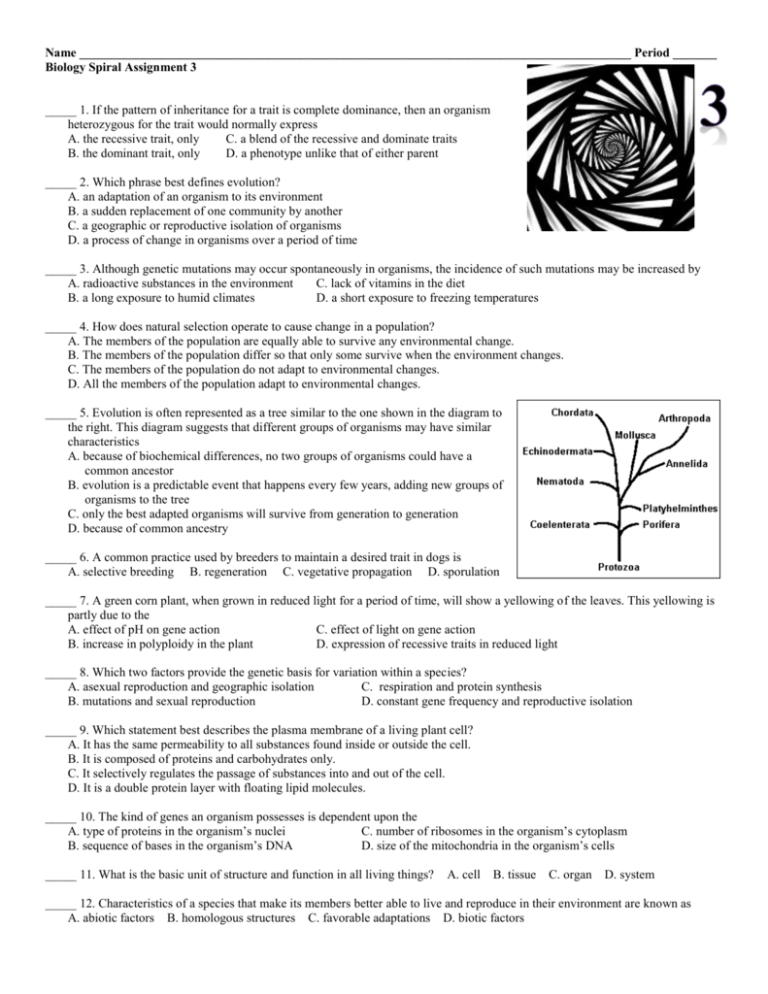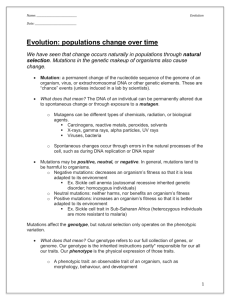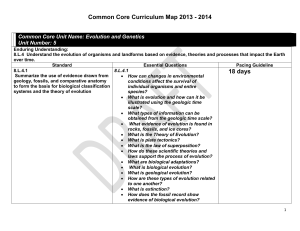Biology Spiral Assignment 3
advertisement

Name ________________________________________________________________________________________ Period _______ Biology Spiral Assignment 3 _____ 1. If the pattern of inheritance for a trait is complete dominance, then an organism heterozygous for the trait would normally express A. the recessive trait, only C. a blend of the recessive and dominate traits B. the dominant trait, only D. a phenotype unlike that of either parent _____ 2. Which phrase best defines evolution? A. an adaptation of an organism to its environment B. a sudden replacement of one community by another C. a geographic or reproductive isolation of organisms D. a process of change in organisms over a period of time _____ 3. Although genetic mutations may occur spontaneously in organisms, the incidence of such mutations may be increased by A. radioactive substances in the environment C. lack of vitamins in the diet B. a long exposure to humid climates D. a short exposure to freezing temperatures _____ 4. How does natural selection operate to cause change in a population? A. The members of the population are equally able to survive any environmental change. B. The members of the population differ so that only some survive when the environment changes. C. The members of the population do not adapt to environmental changes. D. All the members of the population adapt to environmental changes. _____ 5. Evolution is often represented as a tree similar to the one shown in the diagram to the right. This diagram suggests that different groups of organisms may have similar characteristics A. because of biochemical differences, no two groups of organisms could have a common ancestor B. evolution is a predictable event that happens every few years, adding new groups of organisms to the tree C. only the best adapted organisms will survive from generation to generation D. because of common ancestry _____ 6. A common practice used by breeders to maintain a desired trait in dogs is A. selective breeding B. regeneration C. vegetative propagation D. sporulation _____ 7. A green corn plant, when grown in reduced light for a period of time, will show a yellowing of the leaves. This yellowing is partly due to the A. effect of pH on gene action C. effect of light on gene action B. increase in polyploidy in the plant D. expression of recessive traits in reduced light _____ 8. Which two factors provide the genetic basis for variation within a species? A. asexual reproduction and geographic isolation C. respiration and protein synthesis B. mutations and sexual reproduction D. constant gene frequency and reproductive isolation _____ 9. Which statement best describes the plasma membrane of a living plant cell? A. It has the same permeability to all substances found inside or outside the cell. B. It is composed of proteins and carbohydrates only. C. It selectively regulates the passage of substances into and out of the cell. D. It is a double protein layer with floating lipid molecules. _____ 10. The kind of genes an organism possesses is dependent upon the A. type of proteins in the organism’s nuclei C. number of ribosomes in the organism’s cytoplasm B. sequence of bases in the organism’s DNA D. size of the mitochondria in the organism’s cells _____ 11. What is the basic unit of structure and function in all living things? A. cell B. tissue C. organ D. system _____ 12. Characteristics of a species that make its members better able to live and reproduce in their environment are known as A. abiotic factors B. homologous structures C. favorable adaptations D. biotic factors _____ 13. A large population of house flies was sprayed with a newly developed, fast-acting insecticide. The appearance of some house flies that are resistant to this insecticide supports the concept that A. species traits tend to remain constant C. variation exists within a species B. biocides cause mutations D. the environment does not change _____ 14. Which statement best describes the relationship between the number of genes and the number of chromosomes in human skin cells? A. There are more genes than chromosomes in skin cells. B. There are more chromosomes than genes in skin cells. C. There are equal numbers of genes and chromosomes in skin cells. _____ 15. A biologist observed a plant cell in a drop of water as shown in diagram A. The biologist added a 10% salt solution to the slide and observed the cell as shown in diagram B. The change in appearance of the cell resulted from A. B. C. D. more salt moving out of the cell than into the cell more salt moving into the cell than out of the cell more water moving into the cell than out of the cell more water moving out of the cell than into the cell _____ 16. Which statement regarding the functioning of the cell membrane of all organisms is not correct? A. The cell membrane forms a boundary that separates the cellular contents from the outside environment. B. The cell membrane is capable of receiving and recognizing chemical signals. C. The cell membrane forms a barrier that keeps all substances that might harm the cell from entering the cell. D. The cell membrane controls the movement of molecules into and out of the cell. _____ 17. Every single-celled organism is able to survive because it carries out A. sexual reproduction B. autotrophic nutrition C. heterotrophic nutrition D. metabolic activities _____ 18. The shape of a protein molecule is influenced by A. whether it is organic or inorganic C. the number of genes found in the nucleus B. the sequence of amino acids in it D. the number of chromosomes in the cell _____ 19. Which statement is best supported by fossil records? A. Structures such as leg bones and wing bones can originate from the same type of tissue found in embryos. B. Species occupying the same habitat have identical environmental needs. C. The struggle for existence between organisms results in changes in population. D. Many organisms that lived in the past are now extinct. _____ 20. The first life-forms to appear on Earth were most likely A. complex single-celled organisms C. simple single-celled organisms B. complex multicellular organisms D. simple multicellular organisms 21. The diagram shows an interpretation of relationships based on evolutionary theory. The letters represent different species. Explain why species B and C are more closely related than species A and C are. _________________________________________________ _________________________________________________ _________________________________________________ _________________________________________________ _________________________________________________ 22. In the past, a specific antibiotic was effective in killing a certain species of bacteria. Now, most members of this bacterial species are resistant to this antibiotic. Explain how this species of bacteria has become resistant. Your answer must include at least the concepts of: overproduction variation natural selection adaptation to the environment _________________________________________________________________________________________________________ _________________________________________________________________________________________________________ _________________________________________________________________________________________________________ _________________________________________________________________________________________________________ _________________________________________________________________________________________________________ _________________________________________________________________________________________________________ _________________________________________________________________________________________________________ _________________________________________________________________________________________________________ 23. Identify a specific structure in a single-celled organism. State how that structure is involved in the survival of the organism. _________________________________________________________________________________________________________ _________________________________________________________________________________________________________ 24. Biological research has generated knowledge used to diagnose genetic disorders in humans. Explain how a specific genetic disorder can be diagnosed. Your answer must include at least: the name of a genetic disorder that can be diagnosed the name or description of a technique used to diagnose the disorder a description of one characteristic of the disorder _________________________________________________________________________________________________________ _________________________________________________________________________________________________________ _________________________________________________________________________________________________________ _________________________________________________________________________________________________________ 25. Two different types of cells from an organism are shown to the right. Explain how these two different types of cells can function differently in the same organism even though they both contain the same genetic instructions. _________________________________________________________________________________________________________ _________________________________________________________________________________________________________ _________________________________________________________________________________________________________ Base your answer to questions 26 and 27 on the two different cells shown to the right. Only cell A produces substance X. Both cells A and B use substance X. 26. Identify substance X. _______________________________________ 27. Identify the type of organelle in cell A that produces substance X. ______________________________________________ Base your answers to questions 28 and 29 on the information below and on your knowledge of biology. The diagram represents the relationship between beak structure and food in several species of finches in the Galapagos Islands. 28. Identify one bird that would most likely compete for food with the large tree finch. Support your answer. _________________________________________________________________________________________________________ _________________________________________________________________________________________________________ 29. State one reason why the large tree finch and the large ground finch are able to coexist on the same island. _________________________________________________________________________________________________________ _________________________________________________________________________________________________________









